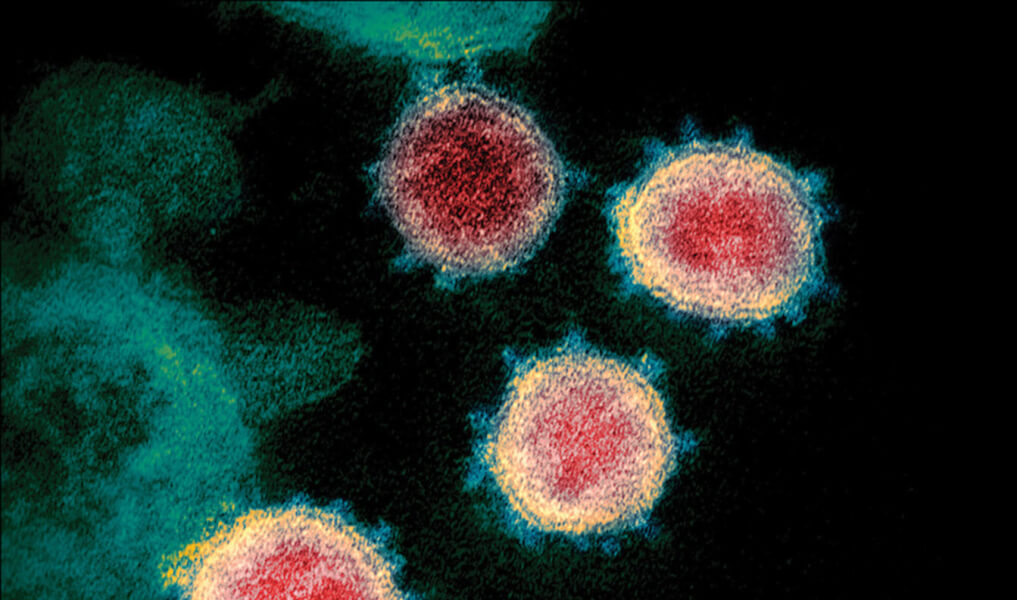Coronaviruses are a large family of viruses that cause illness ranging from the common cold to more severe diseases such as Middle East Respiratory Syndrome (MERS-CoV) and Severe Acute Respiratory Syndrome (SARS-CoV). A novel coronavirus (nCoV-2019) that has not been previously identified in humans is causing COVID-19, a disease that affects the respiratory system. The COVID-19 pandemic remarkably affects every facet of our global and domestic communities and health care systems.
In a healthy individual, the immune system of the body defends the illness and infection. In cancer patients, the immune system can be weakened due to disease as well by treatment modalities such as chemotherapy or radiotherapy that affects adequate white blood cell production by the bone marrow. Patients with cancer especially blood cancers are extremely susceptible to respiratory pathogens & infections.
Thus, cancer patients are comparatively at a higher risk of developing COVID-19 infection. Due to immune-compromised status following patients should take extra precaution:
- Patients with the history of bone marrow or stem cell transplants in the last 6 months, or who are undertaking immunosuppression medications.
- Lung cancer patients undergoing chemotherapy or radiotherapy (masking of lungs related signs & symptoms).
- Blood or bone marrow related cancer such as leukemia, lymphoma or myeloma (at any stage of treatment)
- Cancer patients under the treatment by/with immunotherapy or other antibody treatments.
- Cancer patients under the treatment by targeted therapy which can affect the immune system, such as protein kinase inhibitors or PARP inhibitors.
The symptoms of coronavirus include:
- Fever
- Flu-like symptoms – common cold/cough
- Dry cough
- Sore throat
- Shortness of breath
- Tiredness
- Aches & pains
Atypical presentation – Many people have no symptoms at all – despite being highly contagious – studies suggest a significant proportion of people show other symptoms first, such as diarrhea or loss of smell or taste.
What a cancer patient should do when they develop suspicious symptoms of COVID-19?
If symptoms are mild/ moderate, immediately contact/ consult the treating cancer specialist or a physician. In case of emergency, shortness of breathing, visit the emergency department immediately.
- Contact your doctor or clinic immediately for medical advice If you have COVID-19 symptoms or you’ve been in contact with someone diagnosed with COVID-19.
- Inform the doctor about your symptoms and possible exposure before you go to your appointment.
- If you have mild flu-like symptoms but you are not and have not been in an area with ongoing community spread, contact your doctor or clinic for guidance.
- Let your doctor know if you have other chronic medical conditions, such as heart disease or lung disease. As the pandemic progresses, it’s important to make sure health care is available for those in greatest need.
- If you have emergency COVID-19 signs and symptoms, such as trouble breathing, chest pain or pressure, confusion, or blue lips or face Immediately visit the Emergency department of the nearest hospital / contact the designated Covid Hospital/ Nodal Centre of your locality.
- As per current Govt guidelines only designated Covid hospitals can admit suspected / Confirmed COVID 19 patients.
COVID-19 in Lung Cancer Patients
Lung cancer is predominantly a disease of the elderly with a history of smoking, comorbidities such as chronic obstructive pulmonary disease (COPD), and coronary artery disease. Such patients are more susceptible to the novel coronavirus disease. With the prevalence of the COVID-19 pandemic, the routine medical care of lung cancer patients is affected. Due to the low immunity in these patients after receiving anti-tumor treatment and the side effects of other treatment modalities such as chemotherapy and radiotherapy, it is evident that there can be an increased risk of COVID-19.
Symptoms of the infection in patients with lung cancer include cough, sputum, shortness of breath or difficulty in breathing, and fever. Since symptoms, as well as the after-effects of the treatment, are similar to the symptoms of COVID-19, it is very difficult to identify the early symptoms of the disease through diagnosis. Therefore, it is necessary to have a detailed examination, make a differential diagnosis, and identify the underlying cause of these symptoms. Patients with lung cancer who develop fever and exacerbation of respiratory symptoms need to visit the clinic to get assessed the risk of COVID-19.
Preventive Measures for COVID 19 Infections
Cancer patients should follow Prevention and control guidelines issued by Heath authorities
Personal Hygiene Routine & Family’s Role
- Wash hands with soap and water for 20 seconds or use an alcohol-based hand rub. It is especially important to wash hands before eating or drinking
- Avoid touching eyes, nose and mouth as this can transfer the virus from surfaces and increase the risk of infection
- Respiratory etiquette: covering nose & mouth while sneezing/ coughing
- Preferably wear cloth mask when stepping out of the house
- Family members and caregivers of breast cancer patients should take sufficient measures and be extra careful to avoid the spread of infection. They also should closely monitor the patients
Stock up the medicines and supplies they need which can last for a few weeks. Store the daily essentials for the house which can minimize the trips for grocery stores. - Those with COVID-19 symptoms should not visit their family members in hospitals or other locations before the completion of the self-isolation period.
Cleaning & Disinfecting the Surrounding
- Ensure frequently touched objects and surfaces (such as tables, benches, light switches, doorknobs, sinks, toilets, remotes, mobile phones, or eating surfaces) are Cleaned and disinfected at regular interval.
- If possible, wear disposable gloves when you touch these surfaces/ or wash hands immediately after the touch.
Social Distancing
- Maintain 1-meter physical distance between yourself and others at every point: standing, walking, sitting/sleeping
- Avoid crowds and visiting crowded areas
- Avoid unnecessary physical contact, such as shaking hands, hugging, or kissing. This is very important if you are presently under chemotherapy or having any post-treatments such as bone marrow transplantation
- Avoid contact with sick or unwell people or have been exposed to the virus or recent travel to a high-risk country as it can cause a higher risk of infection
- Stay home as much as possible and avoid non-essential travel and avoid public transport
Seeking Doctor’s Advice/Consultation
- Talk to your doctor or health care team about your visit to the hospital so you can plan your activities accordingly
- For routine follow-ups opt for consultations over the phone, or through video chat or calling if possible
- As per prescription always stock up the medications and supplies that can last for a few weeks
- Observe strict quarantine by staying at home as much as possible
- Boost up the immune system by keeping stress levels low, getting adequate sleep, physical exercise, and a balanced diet can also be helpful
For Healthcare Professionals
There are some of the anticipated challenges for the healthcare professional to cope with the pandemic situation of COVID-19 including:
- Asymptomatic presentation patients under the care
- Staff shortages due to lockdown, quarantine, etc
- Limitations of resources such as mechanical ventilation, hospital beds, and other equipment
- Effect on delivering care /treatment due to travel bans including restricted access to international donors for allogeneic stem cell transplants
- Strategies of dividing cancer healthcare workers in rotational shifts that are epidemiologically consistent with the 14-day incubation time of coronavirus can help protect the safety and wellbeing of the hospital teams.
It is necessary to provide essential cancer services and ensure that all steps are taken to protect all the patients from COVID-19 infection. The individual risk from COVID-19 exposure varies from patient to patient and all risks should be measured against tumor control criteria and should be discussed with the patient.
Emergency cancer care will be prioritized, giving high priority to patients undergoing active disease treatment. However, the advantage of having a well-planned and well-controlled anti-cancer care treatment plan can outweigh the risk of infection with coronavirus in most of the patients.
Medical oncologists, as well as other health professionals, are generally exposed to hazards that may bring them at risk for COVID-19 infection, including exposure to the pathogen, long working hours, and psychological distress. Adequate training and compliance on infection prevention and control are important.
Reinforce Support to Patients
In terms of fear, anxiety, and psychological distress, the effect of COVID-19 pandemic on cancer patients can be high. It is important to bring awareness in the cancer patients on the information about
- adopting certain measures in the prevention and control of infection.
- Discussion on change in the treatment regimen or schedules or any cancellations or delays in the doctor consultations are the key considerations to ensure the wellbeing of cancer patients.
- Video or online consultations to manage follow up visits and non-emergency elective care.
The rationale of Prioritization in Treatment or Diagnosis Scheduling
Cancer treatments, such as surgery, chemotherapy, or radiation therapy, should be weighed against the risk of infection in cancer patients. Many solid tumors (such as lung or pancreatic cancer), hematologic cancers (such as acute leukemia and lymphoma), and certain breast cancers require immediate diagnosis and treatment. Hospital visits for palliative chemotherapy should be discussed with the doctor. Routine timely investigations and follow up can be of great help for the patients to weigh the benefits or risks.
Teleconsultation or online video consultation services should be encouraged for stable patients, particularly those on oral therapy, and to re-evaluate schedules to reduce the number of clinical visits during the pandemic.
Social Distancing During Care Delivery
Social distancing was found to be an effective & promising strategy to deal with pandemic situations in the past. Hence it had been advocated to cope with the early stage of the COVID-19 crisis. The strategy of social distancing and Home isolation in the early stage of the pandemic is advised to reduce community exposure and cross infection due to contact.
Every patient who is undergoing treatment for cancer significantly disrupts the strategy pf social distancing resulting in numerous ripple effects. Patients who tend to be in clinical visits, surgical stays, infusion session, radiation treatments, hospital admissions, and laboratory visits, and x-ray studies along with their family members can be at potential risk of viral transmission.
Hence strategies to minimize the risk of infection and to provide the best possible care to all the patients with very few interruptions need to be developed.
Allocation of Limited Health Care Resources
Cancer care requires significant resources for health care. Throughout the COVID-19 crisis, the use of wards and intensive care unit beds, pharmaceuticals, ventilators, blood products, healthcare personnel, and basic medical supplies for those with COVID-19 can interfere directly in delivering the care to all the patients. The majority of cancer treatments are “elective,” some of the cancers can be considered an emergency. Likewise, various standard treatment approaches such as clinical testing, imaging, and visits to hospitals can be rationalized.
The COVID-19 pandemic has created unique challenges. The oncologists and other healthcare professionals need to be prepared for the wide-spread impact and act accordingly providing all the necessary treatment and prevention for the patients.
References :
- Chinese Journal of Lung Cancer
- Clinical Management of Lung Cancer Patients during the Outbreak of 2019 Novel Coronavirus Disease (COVID-19) By Yan XU, Hongsheng LIU, Ke HU, Mengzhao WANG.
- The National Cancer Institute USA
- Coronavirus: What People with Cancer Should Know
- Science Direct
- Pulmonary Pathology of Early-Phase 2019 Novel Coronavirus (COVID-19) Pneumonia in Two Patients With Lung Cancer
- Cancer Council Australia
- Cancer and Covid-19
- European Society for Medical Oncology
- Lung Cancer in COVID-19 era
- COVID-19 and Cancer
- Breast Cancer in the COVID-19 era
- Annals of Internal Medicine 2020
- Kutikov A, Weinberg DS, Edelman MJ, et al. in the Time of
- Science Dailly
- How to manage cancer care during COVID-19 pandemic
- Cancer Research UK
- Coronavirus (COVID-19) and cancer
- LUNGevity Foundation
- COVID-19 FAQs for people with lung cancer














